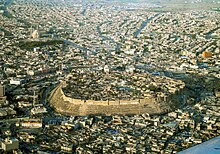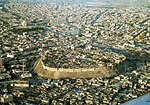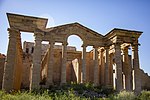
Najaf is the capital city of the Najaf Governorate in central Iraq, about 160 km (99 mi) south of Baghdad. Its estimated population in 2024 is about 1.41 million people. It is widely considered amongst the holiest cities of Shia Islam and one of its spiritual capitals, as well as the center of Shia political power in Iraq.
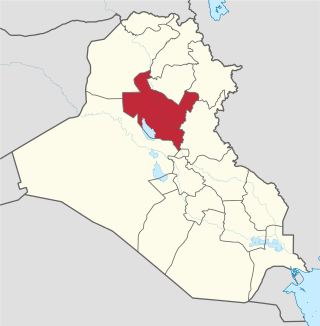
The Saladin, Salah ad Din, or Salah Al-Din Governorate is one of Iraq's 19 governorates, north of Baghdad. It has an area of 24,363 square kilometres (9,407 sq mi), with an estimated population of 1,042,200 people in 2003. It is made up of 8 districts, with the capital being Tikrit. Before 1976 the governorate was part of Baghdad Governorate.
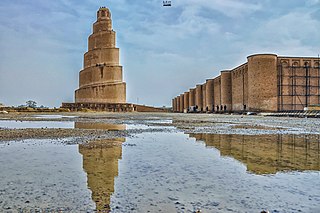
Samarra is a city in Iraq. It stands on the east bank of the Tigris in the Saladin Governorate, 125 kilometers (78 mi) north of Baghdad. The modern city of Samarra was founded in 836 by the Abbasid caliph al-Mu'tasim as a new administrative capital and military base. In 2003 the city had an estimated population of 348,700. During the Iraqi Civil War (2006-08), Samarra was in the "Sunni Triangle" of resistance.

Karbala is a city in central Iraq, located about 100 km (62 mi) southwest of Baghdad, and a few miles east of Lake Milh, also known as Razzaza Lake. Karbala is the capital of Karbala Governorate, and has an estimated population of 691,100 people (2024).
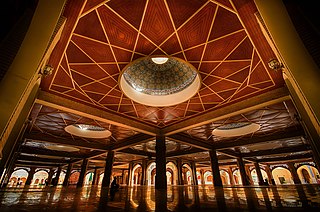
Kufa, also spelled Kufah, is a city in Iraq, about 170 kilometres (110 mi) south of Baghdad, and 10 kilometres (6.2 mi) northeast of Najaf. It is located on the banks of the Euphrates River. The estimated population in 2003 was 110,000. Currently, Kufa and Najaf are joined into a single urban area that is mostly commonly known to the outside world as 'Najaf'.

Islam in Iraq has a rich complicated history that has come to be over almost 1,400 years, since the Prophet Muhammad lived and died in 632 CE. As one of the first places in the world to accept Islam, Iraq is mostly Muslim nation, with about 98% of the people identifying as Muslim. There are the two main types of Islam in Iraq: Shia Islam, which is practiced by about 55-60% of Muslims, and Sunni Islam, which is practiced by about 35-40%.

Religion in Iraq dates back to Ancient Mesopotamia, particularly Sumer, Akkad, Assyria and Babylonia between circa 3500 BC and 400 AD, after which they largely gave way to Judaism, followed by Syriac Christianity and later to Islam. Iraq consists of a multi-ethnic, multi-religious and multi-sectarian population, all living together in one geographical area. The Iraqi civilization was built by peoples and nations, including the Sumerians, Akkadians, Assyrians, Persians, Turks, Arabs, and Babylonians. Religious and cultural circumstances have helped Arabs to become the majority of Iraq’s population today, followed by Kurds, Turkmen, and other nationalities.

Iraq's 18 governorates are subdivided into 120 districts (kaza).

The holiest sites in Islam are located in the Arabian Peninsula. While the significance of most places typically varies depending on the Islamic sect, there is a consensus across all mainstream branches of the religion that affirms two cities as having the highest degree of holiness, in descending order: Mecca, and Medina. Mecca's Al-Masjid al-Haram, Al-Masjid an-Nabawi in Medina are all revered by Muslims as sites of great importance.

Muslims, including Shia, Sunni, Ibadi and other branches, agree on the three holiest sites in Islam being the Masjid al-Haram in Mecca; the Masjid an-Nabawi in Medina; and the Masjid Al-Aqsa in Jerusalem.

Shia Islam in Iraq has a history going back to the times of Ali ibn Abi Talib, the first imam of Shia Islam and fourth caliph of Sunni Islam who moved the capital of the early caliphate from Medina to Kufa two decades after the death of Muhammad. In 2015, Shia Muslims made up between 55% and 60% of the Iraqi population. Iraq is the location of the holy cities of Najaf and Karbala, pilgrimage sites for millions of Shia Muslims.

Shaal Pir Baba was a Sufi saint who was also a leader of the Moudodi Syed's in Balochistan and Sindh, today's Pakistan.

Erbil, also called Hawler, is the capital and most populated city in the Kurdistan Region of Iraq. The city is the capital of the Erbil Governorate.
Shia Muslims have been persecuted by the Islamic State (IS), an Islamist terrorist group, since 2014. Persecutions have taken place in Iraq, Syria, and other parts of the world.
The 2002–03 Iraq FA Cup was the 25th edition of the Iraq FA Cup as a club competition, the main domestic cup in Iraqi football. It kicked off on 2 September 2002, and the final was played on 23 August 2003 at the Franso Hariri Stadium in Erbil.

Al-Atabat Al-Aliyat, which is also known as Al-Atabat Al-Muqaddasa are the shrines of six Shia Imams which are in four cities of Iraq, namely Najaf, Karbala, Kadhimiya and Samarra; and actually the whole of these Imams' shrines (graves) are called Atabat Aliyat. The mentioned cities have significance due to shrines of those six Shia Imams who have been buried there.

The Imam Saad bin Aqil' Shrine is located at Tal Afar, Iraq. The 12th-century shrine contains the tomb of Saad ibn Aqil, a descendant of Aqeel ibn Abi Talib and the governor of Upper Mesopotamia.


